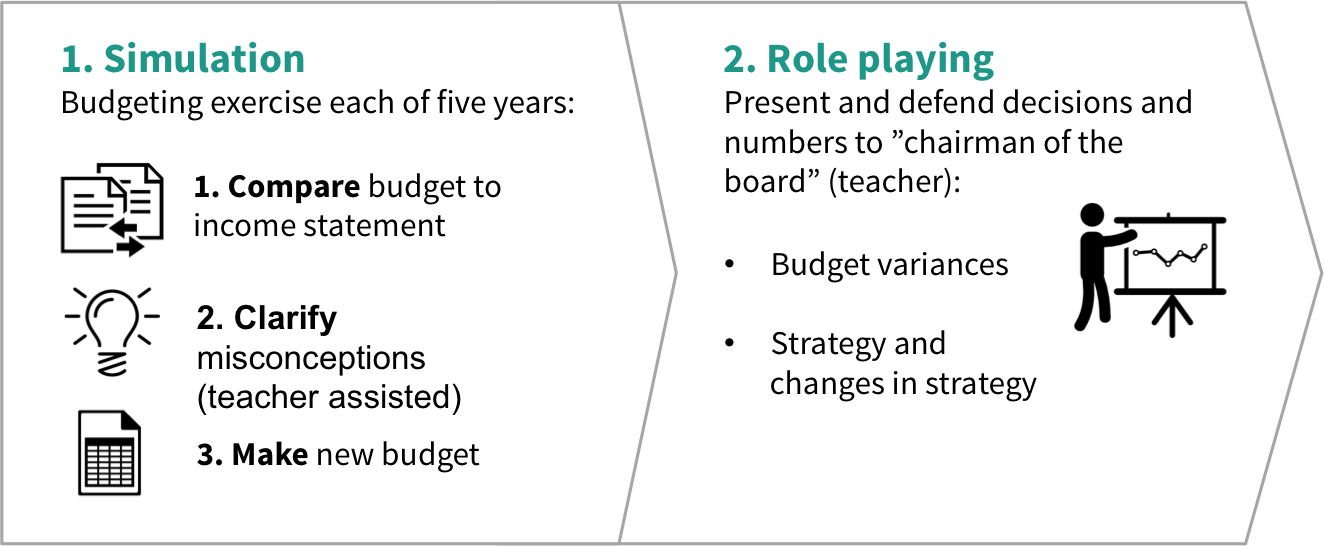
Teaching budgeting with simulation and role playing
Budgeting is a critical skill for any manager: it’s basically putting numbers to all of a companies actions, and thus it’s a central topic in any basic management accounting course.
However, a young student will neither have a good understanding of what the numbers in a budget mean, nor business experience to understand what the numbers describe.
 Emilia Florin Samuelsson, assistant professor of business administration at Jönköping International Business School
Emilia Florin Samuelsson, assistant professor of business administration at Jönköping International Business School
How can an educator give students the best possible understanding of both these aspects and how they fit together?
Emilia Florin Samuelsson, assistant professor at Jönköping International Business School, wanted to give her students a more wholesome approach to budgeting in her Management Accounting course.
– We wanted to let the students use and thereby develop their understanding of concepts and models learned during this course.
Therefore she and her colleagues designed a unique exercise scheme consisting of two parts (see illustration below). First, the students formed groups and ran a simulation with Hubro Business Simulation where they made budgets for each year in the simulation. This made them familiar with each post in the budget and how they described the business. Then, a few days later they had a role playing session where the students presented their key decisions to the “chairman” who was played by a lecturer.

The Jönköping model of teaching budgeting through simulation and role play
Part 1: simulation and budgeting exercises
The first part of the exercise scheme was a 6 hour long simulation, where there was a specific emphasis on the students’ budgeting:
– The students make a lot of decisions in each year of the simulation; the budget summarizes all the decisions made. After each year, we asked the students to compare their accounts to their budget. They then analysed where they had variances because of mistakes in their calculations, and where the reality just did not match their assumptions.
They also had a lecturer function as an “accounting advisor” to the students, who checked the students’ accounts to see what mistakes they were doing. This helped start many educational discussions about budgeting in practice:
– For instance, we pointed out the difference between cost of goods produced and cost of goods sold. We also needed to remind the students about how the bank charged their clients.
According to Paula Bergholm, one of the students that participated in the course, the students appreciated this kind of deliberate practice:
– I got a better understanding of how important budgeting really is. I sincerely believe that accounting should be “learned by doing”.
The other students confirm that the model was successful. In the anonymous assessment of the simulation, an astonishing 100% of the students recommend that the lecturers continue to apply the simulation in the course.
Part 2: board meeting role play
A few days after the simulation, the teams attended a 20 minute meeting with “the chairman of the board” who was played by a lecturer. The teams were asked to explain their budget variances, discuss their strategy and changes in strategy that they decided on during the game.
The role play was a natural extension to the simulation and enhanced the value of the simulation itself. Emilia explains how:
– I think the big benefit with these [role playing] sessions was that it motivated the students to put an effort into the budgeting process. Explaining your decisions and reflecting on what they learned was useful for most groups.
The role play also laid a foundation for other discussions about management accounting in companies:
– It gave us the opportunity to discuss what the budget process looks like in most organizations and how the budget is used in communication between the board and management.
Simulation “fits perfectly” in the Management Accounting course
In addition to making the student practice budgeting, Emilia had another motivation for using the simulation in this particular course:
– We wanted to let the students apply and integrate knowledge gained in different courses.
 It worked. Daniel Jedmo, another of the students in Emilia’s class, says they learned a lot more than just budgeting:
It worked. Daniel Jedmo, another of the students in Emilia’s class, says they learned a lot more than just budgeting:
– I take with me some hands on experience on how you need to plan based on your educated estimates; how the market can always shift, and how competing companies always can give you unexpected trouble, no matter how much you plan ahead.
Daniel, who is in the first year of the International Management program at JIBS, thinks it was very useful to get this kind of exercise this early in the program:
– I would say this is where if fits in perfectly. At this level of knowledge [first year of studies] we don’t have enough knowledge to take on a real market situation, but we do have enough knowledge to complete this kind of exercise.
Apply the “Jönköping model” in your course
Since last fall Emilia and her colleagues have used Hubro Business Simulation in three different courses:
– This is a fun tool for students as well as lecturers! It worked really well both in our International management program and the HR-management program [where they also used the simulation].
How was it for you to use Hubro Business Simulation in this way? Was it time consuming?
– We had fun too! Once you understand the platform and learned the game, it is mostly the hours spent in the classroom besides a little bit of administration. When playing the game the first times, we were advised to run the game with two lecturers present. That was a good advice, but after having used it a few times one lecturer was enough.
That being said, the Hubro Education team hightly recommend other educators to try and reacreate the Jönköping model of teaching budgeting. Please reach out to us for more concrete details on how you can copy the model.
Book a free trial meeting to see how it works
Get a free trialExplore more of our blog for business education, educational business simulations and remote teaching methods.
Back to the blog